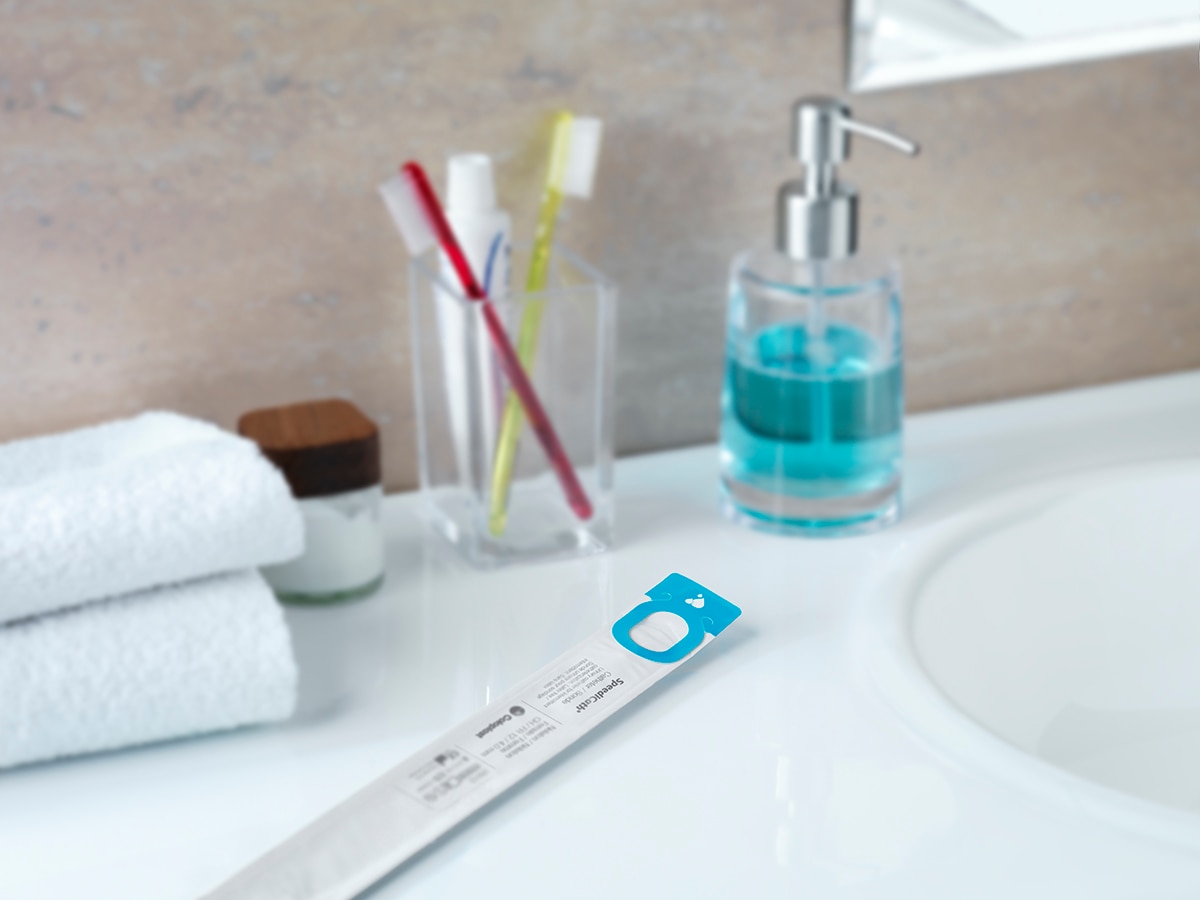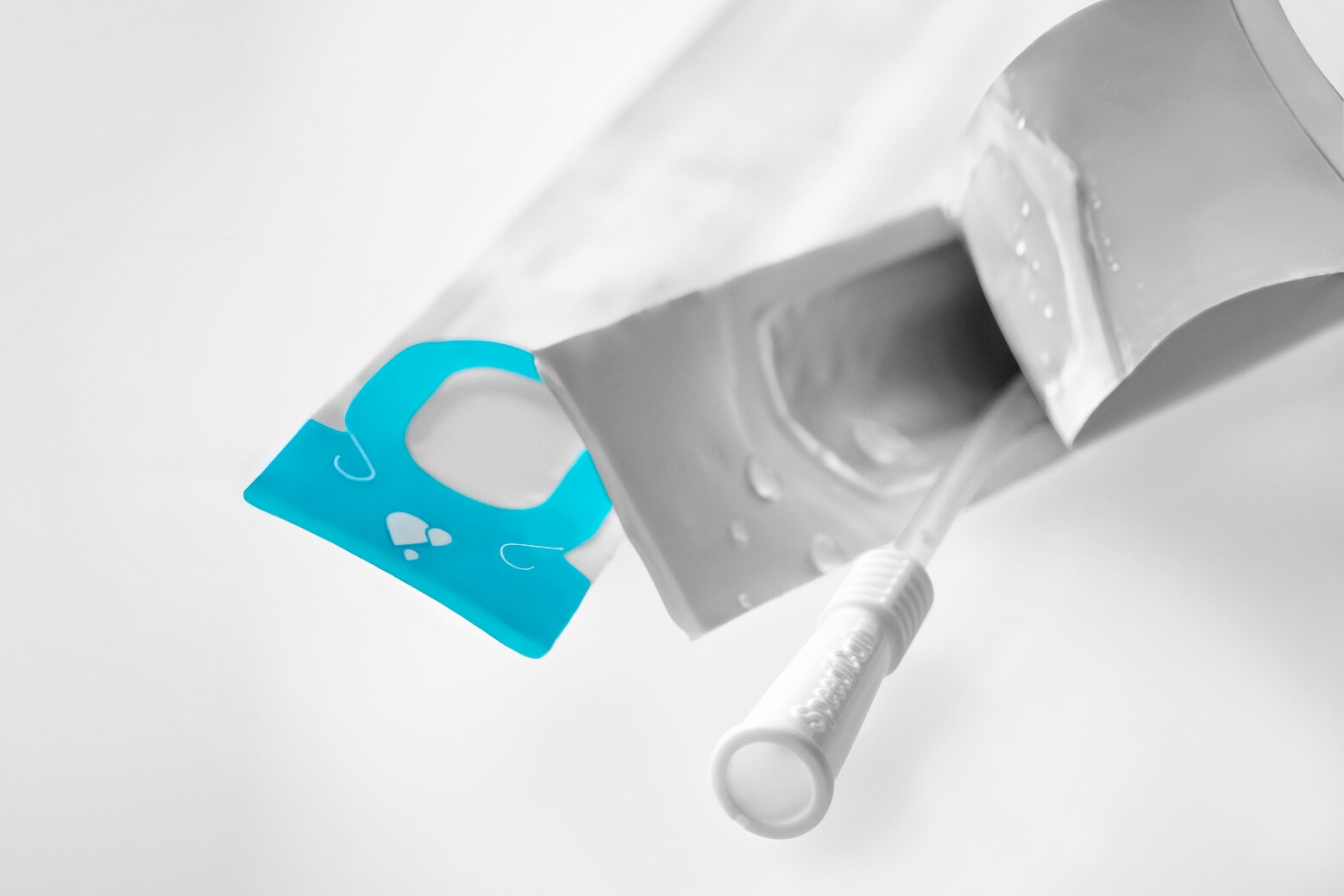
Bladder management methods
People who are not able to empty their bladder themselves (having retention) are introduced to a bladder management method that suits their needs and capabilities. Below is a short description of some of the most common bladder management methods. The overall goal with bladder management is to make sure that the bladder gets emptied to ensure that the bladder stays healthy, and to obtain continence.

Intermittent catheterisation (IC)
An intermittent catheter is a plastic tube that is manually inserted into the bladder via the urethra. When it reaches the bladder urine will start to flow. When the bladder is empty the tube is removed and discarded. The procedure is typically carried out 4-6 times a day (1).
European and American associations recommend IC as the golden standard for bladder emptying when suffering from a neurogenic lower urinary tract dysfunction. When comparing IC to other methods it is proven, that IC is associated with fewer urinary tract infections (UTIs), fewer bladder and kidney stones (2-6). IC provides a higher degree of independence (7), explained by no permanent presence of an indwelling catheter and no or reduced use of diapers, urisheaths and leg bags.
There are two goals when performing IC. The first goal is to keep a low bladder pressure. When the bladder pressure is low, the urine is less likely to flow black to the kidneys and less likely to cause overflow incontinence. To ensure a low bladder pressure the urine volume in the bladder should not exceed 500 ml. The second goal is to keep the bladder healthy and drained and thereby reduce the risk of the urine becoming stale and causing infections. That is done by adhering to the prescribed frequency of catheterisations and to empty the bladder completely each time (1).
Indwelling catheter
An indwelling catheter is a tube that is inserted into the bladder through the urethra and then left there to drain the bladder on an ongoing basis (8).
These catheters are made by a soft material and often inserted using a guide wire. Indwelling catheters are inserted by a health care professional (8).
The catheter is held in place by inflating a balloon at the tip of the catheter with water. The catheter is connected to a drainage bag. The replacement of the indwelling catheter must be at intervals of weeks and is done by health care professionals. The drainage bag is emptied a couple of times a day (8).
The user carries the catheter and the drainage bag at all times (8).
Indwelling catheters are associated with a higher risk of urinary tract infections (2–6) compared to intermittent catheters.
Suprapubic catheter
A suprapubic catheter is an indwelling catheter inserted through the abdominal wall over the pubic area directly into the bladder (9). The procedure is carried out at the hospital by a surgeon. The function of the suprapubic catheter is the same as the indwelling catheter. A small balloon at the tip of the catheter is inflated with water to prevent it from falling out. The catheter is connected to a drainage bag. Alternatively, a valve can be connected to the catheter so it can be emptied at intervals. The replacement of the catheter is typically done at intervals of weeks and is done by health care professionals and can be done at home (9).
The suprapubic catheter is associated with more autonomy for e.g. people in wheelchairs as they will need less help catheterising (3).
Mitrofanoff
The Mitrofanoff procedure is a surgical procedure where the appendix or a small section of the small intestine is separated and used to create a connection between the abdominal wall and the bladder (10). The catheter used for the Mitrofanoff is an intermittent catheter. The procedure makes it easier for the patient to self-catheterise, as it is not necessary to insert a catheter via the urethra, which can be difficult for some people (10).
|
|
Intermittent catheterization |
Indwelling catheter |
Suprapubic catheter |
Mitrofanoff |
|
Independancy |
Higher |
Lower |
Lower |
Higher |
|
Risk of UTI |
Lower risk |
Higher risk |
Higher risk |
Lower |
|
Surgical procedure needed |
No |
No |
Yes |
Yes |
Alternative voiding methods:
- Credé stimulation: Is defined by manually applying pressure on the abdomen over the bladder to press urine out of the bladder (11)
- Vasalva maneuver: Is defined by using the abdominal and diaphragm to increase the bladder pressure and force urine out of the bladder (11)
- Tapping: Is defined by tapping the area over the bladder to trigger the detrusor contractions (12)
Literature
- Balhi S, Mrabet MK. Teaching patients clean intermittent self-catheterisation: key points. Br J Community Nurs. 2020 Dec 2;25(12):586–93.
- Weld KJ, Dmochowski RR. Effect of Bladder Management in Urological Complications in Spinal Cord Injured Patients. J Urol. 2000 Mar;163(3):768–72.
- Krebs J, Wöllner J, Pannek J. Risk Factors for Symptomatic Urinary Tract Infections in Individuals with Chronic Neurogenic Lower Urinary Tract Dysfunction. Spinal Cord. 2016 Sep;54(9):682–6.
- Esclarín De Ruz A, García Leoni E, Herruzo Cabrera R. Epidemiology and Risk Factors for Urinary Tract Infection in Patients with Spinal Cord Injury. J Urol. 2000 Oct;164(4):1285–9.
- Wyndaele JJ, De Sy WA, Claessens H. Evaluation of Different Methods of Bladder Drainage Used in the Early Care of Spinal Cord Injury Patients. Spinal Cord. 1985 Feb;23(1):18–26.
- McGuire EJ, Savastano J. Comparative Urological Outcome in Women with Spinal Cord Injury. J Urol. 1986 Apr;135(4):730–1.
- Vahr S, Cobussen-Boekhorst H, Eikenboom J, Geng V, Holroyd S, Lester M, et al. Catheterisation: Dilatation, Urethal intermittent in adults. EAUN, European Association of Urology Nurses; 2013.
- Jeffery N, Mundy A. Innovations in indwelling urethral catheterisation: Indwelling urethral catheterisation innovations. BJU Int. 2020 May;125(5):664–8.
- Hunter KF, Bharmal A, Moore KN. Long-term bladder drainage: Suprapubic catheter versus other methods: A scoping review. Neurourol Urodyn. 2013 Sep;32(7):944–51.
- Faure A, Cooksey R, Bouty A, Woodward A, Hutson J, O’Brien M, et al. Bladder continent catheterizable conduit (the Mitrofanoff procedure): Long-term issues that should not be underestimated. J Pediatr Surg. 2017 Mar;52(3):469–72.
- Schurch B, Tawadros C, Carda S. Dysfunction of lower urinary tract in patients with spinal cord injury. In: Handbook of Clinical Neurology [Internet]. Elsevier; 2015 [cited 2021 Oct 12]. p. 247–67. Available from: https://linkinghub.elsevier.com/retrieve/pii/B9780444632470000146
- James RE, Palleschi JR. Suprapubic Tap or Aspiration. In: Pfenninger and Fowler’s Procedures for Primary Care. Elsevier; 2011. p. 784–5.
